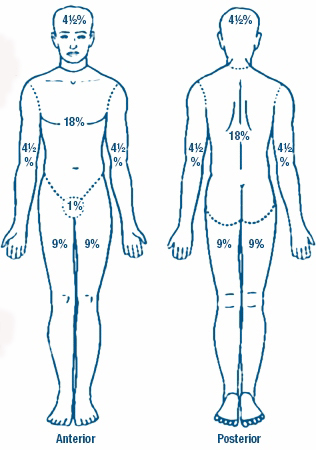ED Presentation
34F with no reported medical history BIBA with severe burns after house fire with estimated 70% TBSA involvement. On arrival, the patient was hypoxic, striderous, and unable to provide history. She was intubated for airway protection with some difficulty. Examination revealed deep partial and full-thickness burns to 70% of total body surface area including circumferential burns to bilateral upper extremities and extensive neck and anterior chest involvement. Initial fluid resuscitation and warming measures were instituted. Emergent bedside bronchoscopy revealed copious carbonaceous material throughout with attempts at lavage. Urine output was minimal despite aggressive resuscitation. Critical care transport to local burn facility was arranged where the patient ultimately expired.
Algorithm for the Management of Severe Burns
Assessment of Burn Depth
| Depth | Cause | Appearance | Sensation |
|---|---|---|---|
| Superficial | UV exposure | Dry, red Blanching |
Painful |
| Superficial partial-thickness | Scald (splash) Short flash |
Blisters, moist, red Blanching |
Painful to temperature/air |
| Deep partial-thickness | Scald (spill) Flame, oil, grease |
Blisters, waxy dry, white/red Non-blanching |
Pressure |
| Full-thickness | Scald (immersion) Flame, steam, oil, grease, chemical, electrical |
Waxy white, leathery grey, black Non-blanching |
Deep pressure |
Estimating Burn Surface Area
- Trunk: 18% anterior, 18% posterior
- Lower extremity (each): 9% anterior, 9% posterior
- Upper extremity (each): 9%
- Head/neck: 9%
- Perineum: 1%
Burn Transfer Criteria
- Partial thickness > 20% TBSA
- Partial thickness > 10% TBSA for extremes of age (<10 or >50 years-old)
- Any full-thickness
- Burns involving face, hands, feet, genitalia, major joints
- Electrical/chemical
- Inhalation injury
- Medical comorbidities impacting management/healing
See Also
References
- Monafo WW. Initial management of burns. N Engl J Med. 1996;335(21):1581–1586. doi:10.1056/NEJM199611213352108.
- Hettiaratchy S, Papini R. Initial management of a major burn: I–overview. BMJ. 2004;328(7455):1555–1557. doi:10.1136/bmj.328.7455.1555.
- Singer AJ, Della-Giustina D. Thermal Burns: Rapid Assessment and Treatment. Emergency Medicine Practice; 2000.
- Rice, PL. Emergency care of moderate and severe thermal burns in adults. In: UpToDate, Moreira ME (Ed), UpToDate, Waltham, MA. (Accessed on March 29, 2016)
- Gauglitz, GG. Overview of the management of the severely burned patient. In: UpToDate, Jeschke MG (Ed), UpToDate, Waltham, MA. (Accessed on March 29, 2016)


